2008年07月08日
八方池、花の最新情報
八方池に友人と娘と一緒に上がってきました。5月末のモーニングコーヒーを
飲んで以来の山でしたが、やはり気持ちの良いさわやかな下界とは
違う風が吹いていました。
どんよりとした梅雨の雲がアルプスを覆っていますが、時折雲の
切れ間から見える山にはまだしっかりと雪が残っています。
八方池も中央部分にはまだとけきらない雪山が残っていました。
山の花もだいぶ咲いてきています。
梅雨明けまでもうすぐでしょうか、いよいよ花も自然もピークに近づいて
来ているようです。
これからは、日々綺麗な山野草、高山植物、そしてふもと白馬を飾る
花達で、きれいになっていきます。
モニカ
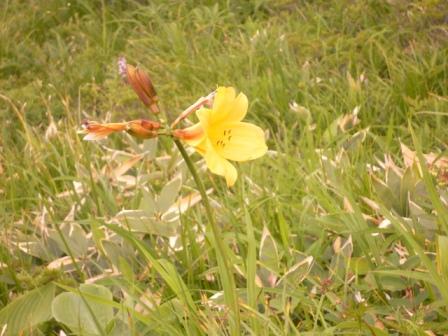


飲んで以来の山でしたが、やはり気持ちの良いさわやかな下界とは
違う風が吹いていました。
どんよりとした梅雨の雲がアルプスを覆っていますが、時折雲の
切れ間から見える山にはまだしっかりと雪が残っています。
八方池も中央部分にはまだとけきらない雪山が残っていました。
山の花もだいぶ咲いてきています。
梅雨明けまでもうすぐでしょうか、いよいよ花も自然もピークに近づいて
来ているようです。
これからは、日々綺麗な山野草、高山植物、そしてふもと白馬を飾る
花達で、きれいになっていきます。
モニカ
2008年07月04日
白馬花三昧2008スタート 花の最新情報
◇◇◇◇◇◇◇ゆりの園からのおたより◇◇◇◇◇◇◇白馬岩岳
7/1より白馬いわたけゆりの園並びに岩岳サマーガーデンOPENしております。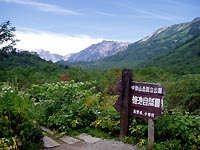
☆★☆本日の開花状況☆★☆
オープン4日目。
薄曇りの朝。毎朝らいちょうペアリフトの下のゆりを見ると何かいつもと違う?
赤色の花が増えてる?数日の間に咲き始めたなぁ・・・ちょっと感動。
つぼみもほんのり色づいてきて、これからさきのゆりの園がすごく楽しみ(^0^)♪
●入園していただいた方にはもれなく、次回来場いただいた時に使える「割引券」と「野菜の種」をプレゼントしております(期間限定)
☆★☆お食事・レストラン☆★☆
●蕎麦打ちマイスターの宮田温巳氏に常駐していただき、打ちたての最高のおソバをご賞味いただけます。
ゆり根の天ぷらの天ざる蕎麦が大好評です!!
●SPF白馬の豚のBBQ、緑豊かな山を眺めながらビール片手に「あ~最高!!」
☆★☆そば打ち体験☆★☆
蕎麦打ちマイスターの宮田温巳氏が蕎麦の歴史から語ります!
蕎麦打ちの秘技を惜しげもなくお教えいたします。
これであなたも『蕎麦打ち名人』への第一歩を踏み出せることでしょう!!
http://www.hakubameister.jp/cgi-bin/detail.cgi?num=086
☆★☆売店☆★☆
ゆり根から作った『ゆり根焼酎』は、岩岳オリジナル・・。ここでしか買うことができません。
※限定300本 「売り切れゴメン」
ほんのり甘く、口あたりがよく女性にも人気です・・。
レストランでお飲みいただくこともできます。
ゆりの香り漂う『ゆりソフト』も好評!!
ヤギさん牧場でのびのび育ったヤギのお乳から作る新鮮なチーズ
(自然食品のため、販売日・数量とも不定です。あればラッキー!)をいかがでしょうか?
その他、詳しい情報
http://web.hakuba.ne.jp/iwatake/green/index.html
これからも随時、情報をご提供させていただきます。
白馬岩岳『ゆりの園』
長野県白馬村岩岳
TEL:0261-72-2472
☆☆☆☆☆☆☆☆栂池高原からのおたより☆☆☆☆☆☆☆栂池パノラマウェイ
■栂池自然園の情報
多くの高山植物が花を咲かせる季節です。園内を歩いていると、間近で見られる花が多くあります。
♪ 栂池自然園開花情報 ♪
---7月2日 現在 ---
例年より10日ほど遅れましたが、ミズバショウが見頃をむかえました。
◇ミズバショウ湿原
ミズバショウ、リュウキンカ、キヌガサソウ、エンレイソウ、ベニバナイチゴ、サンカヨウ、タカネザクラ
◇ワタスゲ湿原
ミズバショウ、ワタスゲ、エンレイソウ、タケシマラン
◇浮島湿原
リュウキンカ、シナノキンバイ、ショウジョウバカマ、タケシマラン、イワカガミ、ムラサキヤシオ、シラネアオイ、イワナシ、マイヅルソウ
◇浮島湿原~モウセン池
ミズバショウ、ムラサキヤシオ、ヒメイチゲ、コミヤマカタバミ、イワカガミ、ミツバオウレン、ショウジョウバカマ、コヨウラクツツジ
◇ヤセ尾根~展望湿原
ショウジョウバカマ、ヒメイチゲ、コヨウラクツツジ、イワカガミ、ムラサキヤシオ、ミツバオウレン、タケシマラン、ゴゼンタチバナ、マイヅルソウ、カラマツソウ
詳しくは↓
http://www.tokyu-hakuba.co.jp/summer/tsugaike/kosyoku/now.htm
●栂池自然園トレッキングレポート↓
http://www.tokyu-hakuba.co.jp/report/tsugaike/
※約一週間毎に更新
■飲食・お土産・温泉の情報
◇からまつ広場
・地元小谷産の山菜を使った、「山菜そば」「山菜うどん」が好評です。
・来週~ その場で焼いた「だんご」「岩魚の塩焼き」も販売します。
・小谷産山ブンドのソフトクリームが大好評!!
・乾物や山野草の販売も行っています。
◇お土産
栂の湯1階売店・ロープウェイ山頂売店では、地場のお土産を取り揃えております。
・からまつ広場で風吹大池で採れた「根曲がり竹」を販売しています。
※数に限りがございますのでお早めに・・!
◇栂の湯
詳しくは↓
http://snownavi.cside9.com/spa/tuganoyu/tuganoyu.html
■栂池パノラマウェイの料金や運行の情報
詳しくは↓
http://www.tokyu-hakuba.co.jp/summer/tsugaike/panorama/pano_in.htm
栂池パノラマウェイ(栂池ゴンドラリフト)
TEL0261-83-2255
FAX0261-83-2002
7/1より白馬いわたけゆりの園並びに岩岳サマーガーデンOPENしております。

☆★☆本日の開花状況☆★☆
オープン4日目。
薄曇りの朝。毎朝らいちょうペアリフトの下のゆりを見ると何かいつもと違う?
赤色の花が増えてる?数日の間に咲き始めたなぁ・・・ちょっと感動。
つぼみもほんのり色づいてきて、これからさきのゆりの園がすごく楽しみ(^0^)♪
●入園していただいた方にはもれなく、次回来場いただいた時に使える「割引券」と「野菜の種」をプレゼントしております(期間限定)
☆★☆お食事・レストラン☆★☆
●蕎麦打ちマイスターの宮田温巳氏に常駐していただき、打ちたての最高のおソバをご賞味いただけます。
ゆり根の天ぷらの天ざる蕎麦が大好評です!!
●SPF白馬の豚のBBQ、緑豊かな山を眺めながらビール片手に「あ~最高!!」
☆★☆そば打ち体験☆★☆
蕎麦打ちマイスターの宮田温巳氏が蕎麦の歴史から語ります!
蕎麦打ちの秘技を惜しげもなくお教えいたします。
これであなたも『蕎麦打ち名人』への第一歩を踏み出せることでしょう!!
http://www.hakubameister.jp/cgi-bin/detail.cgi?num=086
☆★☆売店☆★☆
ゆり根から作った『ゆり根焼酎』は、岩岳オリジナル・・。ここでしか買うことができません。
※限定300本 「売り切れゴメン」
ほんのり甘く、口あたりがよく女性にも人気です・・。
レストランでお飲みいただくこともできます。
ゆりの香り漂う『ゆりソフト』も好評!!
ヤギさん牧場でのびのび育ったヤギのお乳から作る新鮮なチーズ
(自然食品のため、販売日・数量とも不定です。あればラッキー!)をいかがでしょうか?
その他、詳しい情報
http://web.hakuba.ne.jp/iwatake/green/index.html
これからも随時、情報をご提供させていただきます。
白馬岩岳『ゆりの園』
長野県白馬村岩岳
TEL:0261-72-2472
☆☆☆☆☆☆☆☆栂池高原からのおたより☆☆☆☆☆☆☆栂池パノラマウェイ
■栂池自然園の情報
多くの高山植物が花を咲かせる季節です。園内を歩いていると、間近で見られる花が多くあります。
♪ 栂池自然園開花情報 ♪
---7月2日 現在 ---
例年より10日ほど遅れましたが、ミズバショウが見頃をむかえました。
◇ミズバショウ湿原
ミズバショウ、リュウキンカ、キヌガサソウ、エンレイソウ、ベニバナイチゴ、サンカヨウ、タカネザクラ
◇ワタスゲ湿原
ミズバショウ、ワタスゲ、エンレイソウ、タケシマラン
◇浮島湿原
リュウキンカ、シナノキンバイ、ショウジョウバカマ、タケシマラン、イワカガミ、ムラサキヤシオ、シラネアオイ、イワナシ、マイヅルソウ
◇浮島湿原~モウセン池
ミズバショウ、ムラサキヤシオ、ヒメイチゲ、コミヤマカタバミ、イワカガミ、ミツバオウレン、ショウジョウバカマ、コヨウラクツツジ
◇ヤセ尾根~展望湿原
ショウジョウバカマ、ヒメイチゲ、コヨウラクツツジ、イワカガミ、ムラサキヤシオ、ミツバオウレン、タケシマラン、ゴゼンタチバナ、マイヅルソウ、カラマツソウ
詳しくは↓
http://www.tokyu-hakuba.co.jp/summer/tsugaike/kosyoku/now.htm
●栂池自然園トレッキングレポート↓
http://www.tokyu-hakuba.co.jp/report/tsugaike/
※約一週間毎に更新
■飲食・お土産・温泉の情報
◇からまつ広場
・地元小谷産の山菜を使った、「山菜そば」「山菜うどん」が好評です。
・来週~ その場で焼いた「だんご」「岩魚の塩焼き」も販売します。
・小谷産山ブンドのソフトクリームが大好評!!
・乾物や山野草の販売も行っています。
◇お土産
栂の湯1階売店・ロープウェイ山頂売店では、地場のお土産を取り揃えております。
・からまつ広場で風吹大池で採れた「根曲がり竹」を販売しています。
※数に限りがございますのでお早めに・・!
◇栂の湯
詳しくは↓
http://snownavi.cside9.com/spa/tuganoyu/tuganoyu.html
■栂池パノラマウェイの料金や運行の情報
詳しくは↓
http://www.tokyu-hakuba.co.jp/summer/tsugaike/panorama/pano_in.htm
栂池パノラマウェイ(栂池ゴンドラリフト)
TEL0261-83-2255
FAX0261-83-2002
2008年07月03日
Gardens in Hakuba
If you come in Hakuba take your time and go for a long walk. You will be very pleasant surprised not only of the beautiful mountains seen in white and green but also by the beautiful gardens with flowers and nice arrangements.
Japanese people like flowers and everyone works hard to keep his garden beautiful. Hakuba is famous for big snowfalls but even those can’t destroy the gardens because their owners work hard to maintain them.
In my walk I could enjoy gardens from simple ones until more sophisticated gardens as Japanese gardens.
I even enjoyed seeing many bonsai in one of the gardens.






Japanese gardens (日本庭園 nihon teien), that is, gardens in traditional Japanese style, can be found at private homes, in neighborhood or city parks, and at historical landmarks such as Buddhist temples and old castles.
In Japanese culture, garden-making is a high art, intimately related to the linked arts of calligraphy and ink painting.
Typical Japanese gardens have at their center a home from which the garden is viewed.
In addition to residential architecture, Japanese gardens often contain several of these elements:
- Water, real or symbolic.
- Rocks.
- A lantern, typically of stone.
- A teahouse or pavilion.
- An enclosure device such as a hedge, fence, or wall of traditional character.
- A bridge to the island, or stepping stones.
Though often thought of as tranquil sanctuaries that allow individuals to escape from the stresses of daily life, Japanese gardens are designed for a variety of purposes. Some gardens invite quiet contemplation, but may have also been intended for recreation, the display of rare plant specimens, or the exhibition of unusual rocks.
Stones are used to construct the garden's paths, bridges, and walkways. Stones can also represent a geological presence where actual mountains are not viewable or present. They are sometimes placed in odd numbers and a majority of the groupings reflect triangular shapes, which often are the mountains of China.
A water source in a Japanese garden should appear to be part of the natural surroundings; this is why one will not find fountains in traditional gardens. Man-made streams are built with curves and irregularities to create a serene and natural appearance. Lanterns are often placed beside some of the most prominent water basins (either a pond or a stream) in a garden. In some gardens one will find a dry pond or stream. Dry ponds and streams have as much impact as do the ones filled with water.
Green plants are another element of Japanese gardens. Japanese traditions prefer subtle green tones, but flowering trees and shrubs are also used.
Japanese people like flowers and everyone works hard to keep his garden beautiful. Hakuba is famous for big snowfalls but even those can’t destroy the gardens because their owners work hard to maintain them.
In my walk I could enjoy gardens from simple ones until more sophisticated gardens as Japanese gardens.
I even enjoyed seeing many bonsai in one of the gardens.






Japanese gardens (日本庭園 nihon teien), that is, gardens in traditional Japanese style, can be found at private homes, in neighborhood or city parks, and at historical landmarks such as Buddhist temples and old castles.
In Japanese culture, garden-making is a high art, intimately related to the linked arts of calligraphy and ink painting.
Typical Japanese gardens have at their center a home from which the garden is viewed.
In addition to residential architecture, Japanese gardens often contain several of these elements:
- Water, real or symbolic.
- Rocks.
- A lantern, typically of stone.
- A teahouse or pavilion.
- An enclosure device such as a hedge, fence, or wall of traditional character.
- A bridge to the island, or stepping stones.
Though often thought of as tranquil sanctuaries that allow individuals to escape from the stresses of daily life, Japanese gardens are designed for a variety of purposes. Some gardens invite quiet contemplation, but may have also been intended for recreation, the display of rare plant specimens, or the exhibition of unusual rocks.
Stones are used to construct the garden's paths, bridges, and walkways. Stones can also represent a geological presence where actual mountains are not viewable or present. They are sometimes placed in odd numbers and a majority of the groupings reflect triangular shapes, which often are the mountains of China.
A water source in a Japanese garden should appear to be part of the natural surroundings; this is why one will not find fountains in traditional gardens. Man-made streams are built with curves and irregularities to create a serene and natural appearance. Lanterns are often placed beside some of the most prominent water basins (either a pond or a stream) in a garden. In some gardens one will find a dry pond or stream. Dry ponds and streams have as much impact as do the ones filled with water.
Green plants are another element of Japanese gardens. Japanese traditions prefer subtle green tones, but flowering trees and shrubs are also used.
2008年07月02日
宇宙人がV字飛行でK点越え?
山のホテルの近くに楽しいオブジェがあるので、今朝撮りました。
八方地区で作った案内標識には宇宙人らしき方々がいろいろなポーズで
取り付けられています。
これはとあるホテルの前に備え付けられている綺麗なV字で飛ぶ宇宙人。
八方地区にはこの標識がいたるところにありますから、いろいろなポーズを
散歩がてら探してみるとちょっと楽しいかもしれません。
支配人 武藤慶太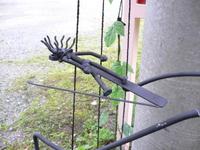


八方地区で作った案内標識には宇宙人らしき方々がいろいろなポーズで
取り付けられています。
これはとあるホテルの前に備え付けられている綺麗なV字で飛ぶ宇宙人。
八方地区にはこの標識がいたるところにありますから、いろいろなポーズを
散歩がてら探してみるとちょっと楽しいかもしれません。
支配人 武藤慶太
2008年07月01日
Miso- making and some details
Today I took part in the process of making miso paste. It was an enjoyable experience. My friend Yoko organized and prepared the ingredients and I joined their group. The Japanese ladies brought their children and the bigger ones helped to mix the ingredients.
It was nice to see all of them enjoying mixing and adding the ingredients. In the attached pictures you can see me with my daughter Erika, Emi-san with her daughter very involved in the process, a little bit behind is Yoko-san (has a light blue head-kerchief) and of course the group of ladies working hard.
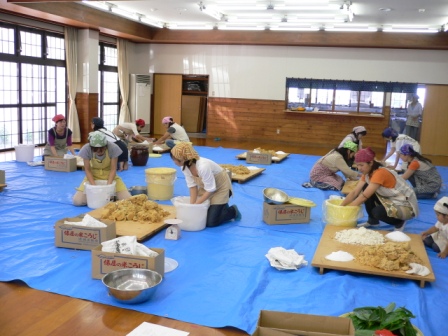
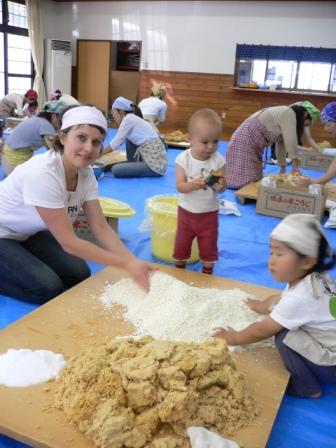

Miso is a traditional Japanese food produced by fermenting rice, barley and/or soybeans, with salt and the fungus kōjikin.
For centuries Japanese craftsmen, using natural fermentation, have transformed soybeans and grains into a delicious and versatile staple food and seasoning called miso.
Rich and savory, miso adds a harmonizing flavor to a wide variety of dishes.
We made miso (soy-bean paste) using daizu (dried soybeans), kōji (kōji is a kind of mold having enzyme to convert starch to sugar. Kōji is used for making Sake (Japanese rice brew), Miso (soy-bean paste), Shoyu (soy-sauce), etc.), salt and miso-kin.
Miso is a part of many Japanese-style meals. It most commonly appears as the main ingredient of miso soup, which is eaten daily by much of the Japanese population. The pairing of plain rice and miso soup is considered a fundamental unit of Japanese cuisine. This pairing is the basis of a traditional Japanese breakfast.
High in protein and rich in vitamins and minerals, miso played an important nutritional role in feudal Japan. Miso is still very widely used in Japan, both in traditional and modern cooking, and has been gaining world-wide interest.
Like fine wines, each miso has a distinct flavor, color and aroma.
The ingredients used, temperature and duration of fermentation, salt content, variety of kōji, and fermenting vessel all contribute. Throughout Japan, even today, each region is proud of its own type of miso.
The most common flavor categories of soy miso are:
- Shiromiso, "white miso"
- Akamiso, "red miso"
- Kuromiso, "black miso"
- Hatchomiso
White and red (shiromiso and akamiso) are the basic types of miso available in all of Japan as well as overseas. Different varieties are preferred in particular regions. For example, in the eastern Kantō region that includes Tokyo, the lighter shiromiso is popular, while in the western Kansai region encompassing Osaka, Kyoto, and Kobe, darker brownish hatchomiso is preferred, and akamiso is favoured in the Tohoku area.
HATCHO MISO is an extraordinary source of concentrated nutrition.
Miso is known as a good source of protein, and Hatcho miso contains 80% more protein and 20-25% less salt than long-aged rice and barley misos.
Moreover, Hatcho miso is a source of essential amino acids, minerals, and vitamins, is low in calories and fat, and has five times the fiber of an equal amount of celery.
Considered an important medicinal food, its daily use is credited with numerous health benefits, including lowering cholesterol, alkalinizing the blood, neutralizing the effects of smoking and environmental pollution, and helping toprevent radiation sickness. (Immediately after the Chernobyl accident in l986, European customers ordered over 40 tons of Hatcho miso believing it to be most powerful against the effect of radiation.)
Like yogurt, unpasteurized Hatcho miso is abundant in lactic acid bacteria and enzymes which aid digestion and food assimilation.
Japanese people have traditionally used miso in soup twice a day for this very reason.
Monica Muto
It was nice to see all of them enjoying mixing and adding the ingredients. In the attached pictures you can see me with my daughter Erika, Emi-san with her daughter very involved in the process, a little bit behind is Yoko-san (has a light blue head-kerchief) and of course the group of ladies working hard.



Miso is a traditional Japanese food produced by fermenting rice, barley and/or soybeans, with salt and the fungus kōjikin.
For centuries Japanese craftsmen, using natural fermentation, have transformed soybeans and grains into a delicious and versatile staple food and seasoning called miso.
Rich and savory, miso adds a harmonizing flavor to a wide variety of dishes.
We made miso (soy-bean paste) using daizu (dried soybeans), kōji (kōji is a kind of mold having enzyme to convert starch to sugar. Kōji is used for making Sake (Japanese rice brew), Miso (soy-bean paste), Shoyu (soy-sauce), etc.), salt and miso-kin.
Miso is a part of many Japanese-style meals. It most commonly appears as the main ingredient of miso soup, which is eaten daily by much of the Japanese population. The pairing of plain rice and miso soup is considered a fundamental unit of Japanese cuisine. This pairing is the basis of a traditional Japanese breakfast.
High in protein and rich in vitamins and minerals, miso played an important nutritional role in feudal Japan. Miso is still very widely used in Japan, both in traditional and modern cooking, and has been gaining world-wide interest.
Like fine wines, each miso has a distinct flavor, color and aroma.
The ingredients used, temperature and duration of fermentation, salt content, variety of kōji, and fermenting vessel all contribute. Throughout Japan, even today, each region is proud of its own type of miso.
The most common flavor categories of soy miso are:
- Shiromiso, "white miso"
- Akamiso, "red miso"
- Kuromiso, "black miso"
- Hatchomiso
White and red (shiromiso and akamiso) are the basic types of miso available in all of Japan as well as overseas. Different varieties are preferred in particular regions. For example, in the eastern Kantō region that includes Tokyo, the lighter shiromiso is popular, while in the western Kansai region encompassing Osaka, Kyoto, and Kobe, darker brownish hatchomiso is preferred, and akamiso is favoured in the Tohoku area.
HATCHO MISO is an extraordinary source of concentrated nutrition.
Miso is known as a good source of protein, and Hatcho miso contains 80% more protein and 20-25% less salt than long-aged rice and barley misos.
Moreover, Hatcho miso is a source of essential amino acids, minerals, and vitamins, is low in calories and fat, and has five times the fiber of an equal amount of celery.
Considered an important medicinal food, its daily use is credited with numerous health benefits, including lowering cholesterol, alkalinizing the blood, neutralizing the effects of smoking and environmental pollution, and helping toprevent radiation sickness. (Immediately after the Chernobyl accident in l986, European customers ordered over 40 tons of Hatcho miso believing it to be most powerful against the effect of radiation.)
Like yogurt, unpasteurized Hatcho miso is abundant in lactic acid bacteria and enzymes which aid digestion and food assimilation.
Japanese people have traditionally used miso in soup twice a day for this very reason.
Monica Muto
2008年07月01日
オーナー武藤衛 オープン13周年になりました
早いもので7月1日。
山のホテルがオープンして13周年です。平成7年6月30日、オリンピックのジャンプ台の前にオープンしました。
当日は荻原健司,次晴さんはじめ地元のかたがた、私の友人、相撲の関係者、スキーの関係者、スポーツの仲間、同業の方はじめ多くのかたがたが祝福に見えました。
その後はジャンプ日本チームの合宿が行われ、後の金メタルの獲得と続きます。当時の日本選手には不敗神話というようなオーラがありました、なんともいえない自信の表れだと思います。
そして結果は金メタル、なんとも良い時代をともに過ごしたと思います。
当時50歳若くて元気がありました、これを読んで何か思い出話のある方はどうぞメール下さい。
山のホテルがオープンして13周年です。平成7年6月30日、オリンピックのジャンプ台の前にオープンしました。
当日は荻原健司,次晴さんはじめ地元のかたがた、私の友人、相撲の関係者、スキーの関係者、スポーツの仲間、同業の方はじめ多くのかたがたが祝福に見えました。
その後はジャンプ日本チームの合宿が行われ、後の金メタルの獲得と続きます。当時の日本選手には不敗神話というようなオーラがありました、なんともいえない自信の表れだと思います。
そして結果は金メタル、なんとも良い時代をともに過ごしたと思います。
当時50歳若くて元気がありました、これを読んで何か思い出話のある方はどうぞメール下さい。
Posted by 白馬 山のホテル at
16:08
│Comments(0)






